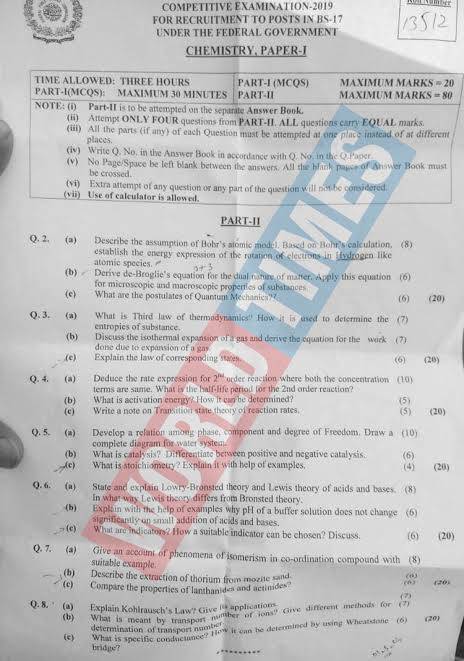COMPETITIVE EXAMINATION-2019
FOR RECRUITMENT TO POSTS IN BS-17 UNDER THE FEDERAL GOVERNMENT
CHEMISTRY, PAPER-I
TIME ALLOWED: THREE HOURS
PART-I (MCQs): MAXIMUM 30 MINUTES PART-II: MAXIMUM MARKS = 80
Instructions:
- Part-II is to be attempted on the separate Answer Book.
- Attempt ONLY FOUR questions from PART-II. ALL questions carry EQUAL marks.
- All parts (if any) of each Question must be attempted at one place instead of at different places.
- Write Q. No. in the Answer Book in accordance with Q. No. in the Q.Paper.
- No Page/Space should be left blank between the answers. All the blank pages of the Answer Book must be crossed.
- Extra attempt of any question or any part of the question will not be considered.
- Use of a calculator is allowed.
PART-I (MCQs)
MAXIMUM MARKS = 20
- Which of the following is an assumption of Bohr’s atomic model?
- (a) Electrons move in circular orbits around the nucleus.
- (b) Electrons move in elliptical orbits around the nucleus.
- (c) Electrons are stationary around the nucleus.
- (d) None of the above.
- What does the third law of thermodynamics state?
- (a) The entropy of a perfect crystal at absolute zero is zero.
- (b) The energy of a system remains constant.
- (c) Heat flows from a colder to a hotter body.
- (d) None of the above.
- What is the activation energy of a reaction?
- (a) The minimum energy required for a reaction to occur.
- (b) The maximum energy required for a reaction to occur.
- (c) The average energy of the reactants.
- (d) None of the above.
- Which equation is derived from de-Broglie’s hypothesis?
- (a) λ=hmv\lambda = \frac{h}{mv}λ=mvh
- (b) E=mc2E = mc^2E=mc2
- (c) PV=nRTPV = nRTPV=nRT
- (d) None of the above.
- What does Kohlrausch’s Law state?
- (a) The conductance of an electrolyte solution at infinite dilution is the sum of the individual ionic conductances.
- (b) The energy of a system is quantized.
- (c) The rate of reaction is proportional to the product of the active masses.
- (d) None of the above.
PART-II
MAXIMUM MARKS = 80
NOTE: Attempt any FOUR questions. All questions carry equal marks.
- (a) Describe the assumption of Bohr’s atomic model. Based on Bohr’s calculations, establish the energy expression for the rotation of electrons in hydrogen-like atomic species. (8 marks) (b) Derive de-Broglie’s equation for the dual nature of matter. Apply this equation for microscopic and macroscopic properties of substances. (6 marks) (c) What are the postulates of Quantum Mechanics? (6 marks)
- (a) What is the third law of thermodynamics? How is it used to determine the entropies of substances? (8 marks) (b) Discuss the isothermal expansion of a gas and derive the equation for the work done due to expansion of a gas. (7 marks) (c) Explain the law of corresponding states. (5 marks)
- (a) Deduce the rate expression for a second-order reaction where both concentration terms are the same. What is the half-life period for the second-order reaction? (10 marks) (b) What is activation energy? How can it be determined? (6 marks) (c) Write a note on the Transition State Theory of reaction rates. (4 marks)
- (a) Develop a relation among phase, component, and degree of freedom. Draw a complete diagram for the water system. (10 marks) (b) What is catalysis? Differentiate between positive and negative catalysis. (6 marks) (c) What is stoichiometry? Explain it with the help of examples. (4 marks)
- (a) State and explain Lowry-Bronsted theory and Lewis theory of acids and bases. In what way does the Lewis theory differ from the Bronsted theory? (8 marks) (b) Explain with the help of examples why the pH of a buffer solution does not change significantly on the small addition of acids and bases. (6 marks) (c) What are indicators? How can a suitable indicator be chosen? Discuss. (6 marks)
- (a) Give an account of the phenomena of isomerism in coordination compounds with suitable examples. (8 marks) (b) Describe the extraction of thorium from monazite sand. (6 marks) (c) Compare the properties of lanthanides and actinides. (6 marks)
- (a) Explain Kohlrausch’s Law. Give its applications. (7 marks) (b) What is meant by the transport number of ions? Give different methods for the determination of the transport number. (7 marks) (c) What is specific conductance? How can it be determined by using a Wheatstone bridge? (6 marks)
PMS Chemistry Paper 2019 Image

Recommended Reading: PMS GK Paper 2021 | PMS General Knowledge Past paper 2021


Add a Comment